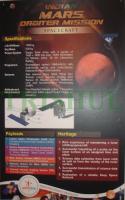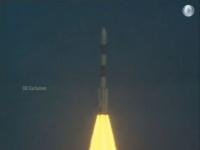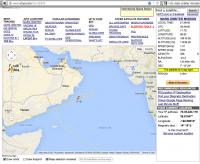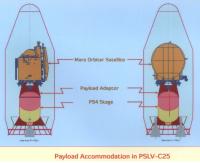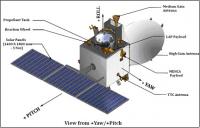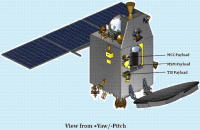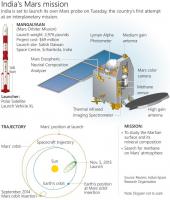Printable Version of Topic
Click here to view this topic in its original format
Unmanned Spaceflight.com _ ISRO Mars Orbiter Mission _ India's Mars probe (MOM)
Posted by: Paolo Aug 31 2009, 08:10 PM
according to the Chinese Xinhua press agency an Indian Mars probe may be launched in 2013 or 2015, after Chandrayaan-2
http://news.xinhuanet.com/english/2009-08/31/content_11972334.htm
Posted by: Paolo Jan 9 2012, 10:18 AM
finally, some info on the proposed Indian Mars mission
http://www.asianscientist.com/topnews/isro-indian-mission-to-mars-red-planet-2013/
2013 is probably too early, 2016 or 2018 may be more realistic.
and Chandrayaan was not that successful, after all...
Posted by: tolis Aug 11 2012, 09:38 PM
While no-one was watching (or had their eyes on Curiosity)
the Indian government approved a national mission to Mars:
http://physicsworld.com/cws/article/news/2012/aug/09/india-set-for-mars-mission-in-2013
Vital statistics:
Launch on PSLV-XL in Nov 2013
500kg, 25kg payload to "..study the planet's geology and climate.."
Highly elliptical orbit around Mars
Good stuff.
Tolis.
Posted by: antipode Aug 11 2012, 11:50 PM
Hmmm, any way to get an Electra comms package onboard?
![]()
P
Posted by: tolis Sep 9 2012, 04:50 PM
Some new info regarding the Indian Mars Probe
From the following article
http://articles.timesofindia.indiatimes.com/2012-08-28/science/33449032_1_mars-orbiter-mission-lunar-mission-methane-mystery
one can infer that one of the science objectives is to look for methane and its sources.
From this
http://www.deccanchronicle.com/channels/sci-tech/space/mars-mission-be-fully-indigenous-isro-217
we learn that no foreign involvement (instruments etc) is foreseen. There is also a reference to the probe as "Mangalyaan"
which makes sense I guess ("Mangala" is one of the words for "Mars" in Sanskrit?).
Tolis.
Posted by: Doc Sep 9 2012, 05:06 PM
From that last article, they hint at the possibility of still having a 2013 launch though there may not be one until 2016.
I'm surprised ISRO has already declared it to be an 'indigneous' mission. They could have solicited a foreign surface package for a light-weight lander to maximise science return.
Posted by: Paolo Sep 10 2012, 07:01 AM
apparently, there are strong political motivations behind the mission. I will not violate forum rules, go have a look to the thread on the nasaspaceflight forum
Posted by: Paolo Sep 18 2012, 06:59 AM
this is interesting http://www.firstpost.com/tech/indias-mars-mission-to-begin-november-2013-459232.html
this looks like the mission profile of the Soviet Fobos missions, of Mars 96 and Fobos-Grunt
Posted by: tolis Sep 18 2012, 03:24 PM
this looks like the mission profile of the Soviet Fobos missions, of Mars 96 and Fobos-Grunt
..as well as Chang'e 1.
When your propulsion system is not very powerful or very accurate,
it is preferable to split large burns into segments (when possible).
This prevents large "gravity losses" (for long burns) and gives
the mission time to measure and correct any under/over burns.
In a nutshell: it saves fuel, when there is not much to spare.
Tolis.
Posted by: rlorenz Sep 19 2012, 08:58 PM
it is preferable to split large burns into segments (when possible).
This prevents large "gravity losses" (for long burns) and gives
the mission time to measure and correct any under/over burns.
I suppose it also makes you more resilient to any pressurization issues, as
in when your nominally regulated system starts operating in blowdown mode,
as Akatsuki did (in effect)
Posted by: tolis Sep 26 2012, 02:40 PM
Indians are cutting (and joining) metal for their orbiter:
http://www.flightglobal.com/news/articles/hal-completes-structure-of-indian-mars-orbiter-376942/
Posted by: tolis Sep 30 2012, 08:08 PM
A nice summing up of the current state of india's Mars orbiter project by Emily Lakdawalla:
http://www.planetary.org/blogs/emily-lakdawalla/2012/09271011-mangalyaan-update.html
For what it's worth, I think that, although the mission development timeframe does seem awfully short, there are also
some reasons to be optimistic:
1. There are indications, eg the delivery of the spacecraft structure, that work on the project began long before the formal
announcement of the mission.
2. Such a fast schedule is not unheard of. The Mariner 9 mission, the US's first Mars orbiter,
was launched in May 1971, 2.5 yr after the formal project start in November 1968. One could argue
that, with a Moon orbiter under its belt, India is in a similar stage in its planetary programme.
3. The technical complexity of the mission, although formidable in absolute terms (it is, after all, a mission to Mars) is
actually quite modest as planetary missions go. The goal is to attain a highly elliptical orbit around Mars and conduct
observations of the planet from this orbit. The one critical maneuvre of the mission (assuming that is is dispatched
from Earth without problems) is a well-timed engine burn near closest approach to the planet on the first pass.
There is no probe to land, no major orbit changes, rendezvous with either one of the moons or sample return.
This is no Phobos-Grunt, more like a Mars Express sans Beagle 2.
So, I would say that there is better than a 50-50 chance of it getting to where it wants to go. Of course, in the real world
it is impossible to fly, say, 10,000 identical missions to see what the actual probability of success is (that's why we have
bayesian statistics, by the way ![]() ) but I remain cautiously optimistic about this one.
) but I remain cautiously optimistic about this one.
Tolis.
Posted by: mcaplinger Sep 30 2012, 09:43 PM
was launched in May 1971, 2.5 yr after the formal project start in November 1968.
There's rather a large difference between 2.5 years and 1.3 years, though it's not clear when Mangalyaan actually started. Also, Mariner Mars 1971 was a direct follow-on to the Mariner 6-7 flyby missions with a lot of heritage, see http://history.nasa.gov/SP-4212/ch6.html
I wish them the best, but it's just not a lot of time.
Posted by: Paolo Oct 1 2012, 05:10 AM
I suspect that Mangalyaan also has a lot of heritage from Chandrayaan. In the structure at least (hopefully not in the thermal control system as well)
Posted by: elakdawalla Oct 1 2012, 05:43 AM
To be fair, the Moon's is a much more challenging thermal environment than Mars'. I think.
Posted by: mcaplinger Oct 1 2012, 02:50 PM
That's certainly true. We ended up using every trick in the book to get LROC to perform in a low lunar orbit.
Posted by: gndonald Jan 4 2013, 11:43 PM
Emily has posted an update on this one, the instruments have been selected and they hope to have them ready for March. I'm going to wish the Indians as much luck as they need for this mission. I'll be happy to see them get the probe onto a Earth - Mars trajectory.
http://www.planetary.org/blogs/emily-lakdawalla/2013/01040907-isro-mars-update.html
In regards the launch profile, I can remember reading somewhere that for countries like India & China that initial 22,000 km orbit is easier to reach because their launch vehicles are optimised for putting communications satellites into that orbit.
Posted by: Paolo Jan 5 2013, 09:32 AM
there was a very short story in Science yesterday (for those having access it's http://www.sciencemag.org/content/339/6115/14.2.summary
just one sentence to retain:
there is also a detailed list of instruments on http://forum.nasaspaceflight.com/index.php?topic=29440.30
note that the Indian methane detector is said to be
i think this is about the same capability as the spectrometer on Mars Express. TGO, IIRC should go for part-per-trillion accuracy
Posted by: machi Jan 5 2013, 11:14 AM
http://www.scribd.com/doc/101457962/Symp-Prl-July12 with short article about electro-optical payload of the Indian Mars mission.
You can find that article quickly by using ctrl+f and simply find "MCC".
Mars Colour Camera is refractor design and it has resolution 25 m/pix (50 microrad) from distance 500 km
It has 2K×2K CCD with RGB Bayer filter for visible light between 0.4 to 0.7 microns.
Frame size is 50×50 km from perigee and 8,000×8,000 km from apogee.
Methane Sensor for Mars (MSM) is Fabry-Perot interferometer with ppb detection limit for methane. It works in narrow SWIR window (1642-1658 nm).
Thermal Infra-Red Imaging Specrometer (TIS) is grating spectrometer with uncooled microbolometer array for TIR between 7 to 14 microns.
Posted by: tolis Jan 5 2013, 12:19 PM
The high apocentre makes it - in principle - capable of flying by Deimos.
Neither MEX nor the other orbiters currently operating around Mars
can approach that moon.
Posted by: Cosmic Penguin Feb 26 2013, 07:05 AM
A paper on the mission to be presented on the 44th LPSC: http://www.lpi.usra.edu/meetings/lpsc2013/pdf/2760.pdf
Edit: http://trishul-trident.blogspot.com/2013/02/highlights-of-aero-india-2013-expo-part.html:
Posted by: SFJCody Feb 27 2013, 05:09 AM
I notice that this is scheduled to arrive at Mars a month before C/2013 A1 (Siding Spring) which has a current nominal flyby distance of 100,000 km (likely to change significantly as the arc length increases). I wonder whether it would be possible to engineer some sort of flyby following orbit insertion? I imagine this is either impossible or would require the expenditure of much more propellant than ISRO would be prepared to sacrifice.
Posted by: Explorer1 Feb 27 2013, 05:45 AM
Way too many factors to consider right now. If anything, MAVEN be the most suited to getting a whiff of the tail, given its instruments being specialized for rarefied gases. Would instrument commissioning even been done for either spacecraft that soon after arrival?
And of course, it's really up to the comet to decide where to pass and how much volatiles to emit...
Posted by: Cosmic Penguin Apr 2 2013, 01:17 PM
Updates from Emily: http://www.planetary.org/blogs/emily-lakdawalla/2013/04011229-isros-mars-mission-now.html ![]()
Posted by: jsheff Jul 9 2013, 01:14 AM
The latest on this mission:
http://www.moneycontrol.com/news/technology/isro-gearsfor-ambitious-mars-mission_913146.html
John Sheff
Cambridge, MA
Posted by: Paolo Jul 24 2013, 05:02 PM
almost everything you wanted to know about MOM http://rd.springer.com/content/pdf/10.1007%2F978-81-322-1521-9_5.pdf
Posted by: Explorer1 Jul 24 2013, 05:19 PM
Looks like there's a concern about Siding Spring's tail interfering with methane measurements; their instrument could confuse cometary material with Mars-originating emissions. Given how quickly methane is destroyed by the sun, would it really be much of a problem, even if some ended up in the atmosphere?
Posted by: Doug M. Jul 29 2013, 09:14 PM
Emily Lakdawalla has another post up on this. Key grafs:
The original plan had been to launch the Mars mission on India's next-generation heavy-lift launch vehicle, the Geosynchronous Satellite Launch Vehicle (GSLV), but delays and one launch disaster have meant that the GSLV has still not yet had a successful flight. India had to choose between delaying to 2016 or launching on the much smaller PSLV. The PSLV cannot send a spacecraft directly on an interplanetary trajectory; it will launch a downsized Mars Orbiter Mission, carrying a 15-kilogram science payload, into Earth orbit, and an upper stage will widen the spacecraft's orbit through multiple boosts into ever-larger ellipses until finally injecting it toward Mars a month later. Once at Mars, the same procedure will operate in reverse, but mass limitations will prevent the spacecraft from carrying enough fuel to bring it down into a low orbit. Instead, it will be in an elliptical orbit with a distant periapsis.
Posted by: Doug M. Jul 29 2013, 09:18 PM
Almost everything... doesn't have anything to say about the Mars orbit. We know from other sources that it will be a polar orbit with a very high apoapsis.
It does mention that a lot of components are being reused from Chandrayaan, as people had already guessed. Also that nominal mission would be six months from arrival in Mars orbit.
Doug M.
Posted by: elakdawalla Jul 29 2013, 11:36 PM
Doug, it's been pointed out to me that I made some errors in the paragraph about the GSLV; I've edited my original post slightly. Sorry about that. (GSLV has had successful flights, though not many; recent failure had to do with a cryogenic upper stage).
http://articles.timesofindia.indiatimes.com/2013-07-24/india/40770603_1_mars-orbiter-mission-chandrayaan-i-mars-colour-camera says that orbit altitude will vary from 385 to 80,000 km, FWIW. That apoapsis is roughly 4 times farther from Mars' center than Deimos' orbit.
Posted by: Doug M. Jul 30 2013, 11:49 AM
http://articles.timesofindia.indiatimes.com/2013-07-24/india/40770603_1_mars-orbiter-mission-chandrayaan-i-mars-colour-camera says that orbit altitude will vary from 385 to 80,000 km, FWIW. That apoapsis is roughly 4 times farther from Mars' center than Deimos' orbit.
Okay! Thanks, Emily.
In theory, Mangalyaan could come fairly close to Deimos. In practice, hoot, who knows. I would imagine that if they arrive in Mars orbit with a little bit of fuel left to play with, a Deimos flyby would at least be discussed.
The gentleman in the article is upset because Mangalyaan is turning out to be more of a technological proof-of-concept than an actual scientific mission. And I can see the force of that. On the other hand, there's precedent; Pathfinder and Sojourner were test beds for lander and rover technology. (As it turned out, they ended up performing much better than expected and delivered some respectable science.)
Doug M.
Posted by: bobik Nov 2 2013, 08:48 AM
MOM Martian orbit parameters:
MOI Epoch: 24-09-2014, 02:34
Periapsis: 365.3 km
Apoapsis: 80000 km
Inclination: 150.0°
AOP: 203.5°
RAAN: 61.4°
Period: 76.72 hr
Sun Elevation: 6.8°
http://www.isro.org/pslv-c25/pdf/pslv-c25-brochure.pdf
Posted by: bobik Nov 4 2013, 10:50 AM
It seems that the Thermal Infrared Imaging Spectrometer (TIS) has a spectral range of 7-14 μm and a spectral resolution of 580 nm (THEMIS: 6.8-14.9 μm and ~1 μm, respectively). http://www.iaeme.com/MasterAdmin/UploadFolder/AN%20EFFECTIVE%20MILLI%20KELVIN%20THERMAL%20MANAGEMENT%20STRATEGY%20FOR%20INFRARED%20IMAGING/AN%20EFFECTIVE%20MILLI%20KELVIN%20THERMAL%20MANAGEMENT%20STRATEGY%20FOR%20INFRARED%20IMAGING.pdf
Posted by: Phil Stooke Nov 4 2013, 02:40 PM
From the Deccan Herald today:
"“We hope to observe Phobos, but not the other one, Diemos, as it is too tiny,” V Adimurthy, senior adviser of interplanetary missions at Isro, told Deccan Herald."
Too bad - Phobos is very well imaged already, Deimos is poorly covered by images especially at high resolution. We really need to see more of it. Even the shape model is very uncertain on the trailing side. China's ill-fated orbiter launched with Phobos-Grunt was going to look at it (I was told personally by a person involved with it). Maybe we will have to wait for the next Chinese orbiter suggested to fly in 2018.
Phil
Posted by: Explorer1 Nov 5 2013, 02:28 AM
Is there a link to the webcast? It's t-7 hours, and the facebook page mentions there will be one, but the ISRO site just shows an old link...
Posted by: elakdawalla Nov 5 2013, 03:29 AM
The website says the webcast will begin at 14:00 IST, which is to say, not for roughly 5 hours.
Posted by: Explorer1 Nov 5 2013, 03:35 AM
I see it now; thanks. Now to wait.
Amazing that a Mars probe can go from first announcement to launch day in only three pages on this of all forums! (not a criticism of anyone, just noting a consequence of the lack of info until the past few weeks)
Posted by: elakdawalla Nov 5 2013, 03:39 AM
Yeah. I do have to say that they're making up for lost time with https://www.facebook.com/pages/ISROs-Mars-Orbiter-Mission/1384015488503058?fref=ts. Lots of info and high-resolution photos.
Posted by: Explorer1 Nov 5 2013, 08:30 AM
Spaceflightnow has the stream starting.
Definitely a different vibe on the preshow from NASA press conferences ![]()
Posted by: jamescanvin Nov 5 2013, 09:07 AM
FYI. I'm finding the mobile video stream from spaceflightnow much more reliable than the desktop feed which was very glitchy for me.
2 mins ...
Posted by: Explorer1 Nov 5 2013, 09:10 AM
Liftoff!
And coasting...
Hope to see good news tomorrow morning.
Posted by: Bjorn Jonsson Nov 5 2013, 09:48 AM
So far so good. The liquid fueled fourth stage has ignited. Hopefully everything works...
Posted by: nprev Nov 5 2013, 12:38 PM
Successfully made initial parking orbit, looking good thus far.
Posted by: Doug M. Nov 6 2013, 08:55 AM
Amazing that a Mars probe can go from first announcement to launch day in only three pages on this of all forums! (not a criticism of anyone, just noting a consequence of the lack of info until the past few weeks)
It hasn't attracted a lot of attention in mainstream media, either. I'd say this is one part India having been rather tight-lipped (reasonable, given that it's their first effort and fingers are crossed) and two parts it not fitting any convenient narrative. India launched a Mars probe... wait, India? Huh?
(Prediction: if China's Moon landing succeeds next month, we will see much, much more media coverage. Because that's going to fit a couple of different narratives really well.)
Doug M.
Posted by: Doug M. Nov 6 2013, 08:56 AM
As of 3 AM EST Tuesday, all systems are nominal. They're going to do their first orbital adjustment later today. Fingers crossed!
Doug M.
Posted by: tolis Nov 6 2013, 08:56 PM
MOI Epoch: 24-09-2014, 02:34
Periapsis: 365.3 km
Apoapsis: 80000 km
Inclination: 150.0°
AOP: 203.5°
RAAN: 61.4°
Period: 76.72 hr
Sun Elevation: 6.8°
http://www.isro.org/pslv-c25/pdf/pslv-c25-brochure.pdf
On the subject of satellite flybys, from the above elements it seems that the orbit crosses the Martian equatorial plane
- where the satellites orbit - at distances from Mars' center of 44,400 km (going south to north) and 3,900 km (going north to south).
So, at least initially the spacecraft can not come particularly close to either of the moons. Later, as the orbit orientation changes due to the action
of the Sun's gravity and Mars' non-spherical shape, encounters with either moon will become possible. Of course, there is no guarantee that the
spacecraft will still be alive then.
Posted by: walfy Nov 7 2013, 06:13 AM
Looks like India's MOM probe can be tracked here: http://www.n2yo.com/?s=39370
Also this link with more info: http://www.n2yo.com/satellite/?s=39370
As it nears its apogee of 28,746.0 km high, there's some projected retrograde motion for it's relative path on Earth's surface, for slowing way down up there, I'm assuming, and Earth's spin overtaking it's orbital speed.
Is it just coincidental that it reached apogee here just as its path reached it's northernmost part on Earth? It can reach apogee at any point along its track on Earth, and does not have to coincide with it's northern or southernmost path along the Earth, right? Probably a dumb question.
Posted by: Explorer1 Nov 7 2013, 07:16 AM
Being in direct contact with India is probably a boon to operations; remaining in orbit to do checkouts/adjustments prior to the Mars trip has more benefits than just a smaller rocket, in terms of signal delay, familiar environment, etc.
Why doesn't this happened more often? Launch a probe into parking orbit when it's assembled, do checkouts and instrument commissioning at a leisurely pace, and burn with your final stage to interplanetary when the appropriate window opens up.
Posted by: Paolo Nov 7 2013, 08:24 AM
I love to be proven wrong sometimes! congratulations to all involved!
Posted by: Doug M. Nov 7 2013, 09:01 AM
I don't know the answer, but two thoughts come immediately to mind. One, checkouts and instrument commissioning don't seem to take all that long -- a few days, at most a week. Two, Earth orbit may not be a good place for deep-space probes to spend lots of time; there are the radiation belts, at perigee they're encountering Earth's exosphere, and so forth. Earth satellites can survive for decades, but they're designed for it. It's possible that a week in Earth orbit might strip several weeks of the potential lifespan of a Mars orbiter.
Doug M.
Posted by: bobik Nov 7 2013, 02:40 PM
"The second and third such operations would be made tomorrow and on Saturday to raise the mission apogee to 40,000 km and 71,650 km respectively. The fourth and fifth operations would be performed to raise the apogee of 1,00,000 km and 1,92,000 km on November 11 and 16 respectively. After the successful completion of these operations, the mission is expected to take on the “crucial event” of the trans-Mars injection around 12.42 am on December 1."
http://www.firstpost.com/india/closer-to-mars-isro-successfully-raises-mangalyaan-orbit-1216297.html?utm_source=ref_article
Posted by: robspace54 Nov 7 2013, 03:27 PM
Glad that the ISRO launch of MOM has been successful. I have some info on the s/c gleaned from the Internet.
MOM is based on a modifieed I-1000 satellite bus, first used in the METSAT-1 weather satellite of 2002, which was later renamed Kalpana-1 to honor the late Indian-Amercian astronaut Kalpana Chawla, who died abord space shuttle Columbia.
Rob
Posted by: mcaplinger Nov 8 2013, 04:04 AM
Most interplanetary spacecraft are launched into a parking orbit, but they only stay in it for a few minutes before injection. AFAIK there are no delta V savings for the MOM mission profile, it's mostly because the spacecraft engine doesn't have enough thrust to do the injection in one burn.
As for checkout, there's plenty of time to do it in cruise, and it's not like you can go up and fix it if you stay in Earth orbit anyway.
Posted by: djellison Nov 8 2013, 06:10 AM
Moreover LEO is a poor place to checkout because you have rapid day/night cycles, and any one DSN pass would only be a few 10's of minutes, rather than a more typical 8 hours. And it's quite possible that LEO on an LGA is a poorer downlink than cruise on an HGA.
Posted by: Explorer1 Nov 11 2013, 05:08 AM
http://www.planetary.org/blogs/emily-lakdawalla/2013/11102001-a-hiccup-for-mars-orbiter-mission.html
Looks like burn four was not completed as planned. They're going to make up the shortfall tomorrow.
This method seems pretty flexible...
Posted by: pospa Nov 11 2013, 01:09 PM
Detail issue explanation in today's ISRO http://www.isro.gov.in/pressrelease/scripts/pressreleasein.aspx?Nov11_2013.
Posted by: pospa Nov 11 2013, 03:28 PM
According to info http://www.bbc.co.uk/news/science-environment-24900271 MOM still has 4 kg fuel reserve today thanks to precise orbit insertion after the launch.
Posted by: mcaplinger Nov 11 2013, 08:59 PM
http://www.planetary.org/blogs/emily-lakdawalla/2013/11110806-mars-orbiter-mission-update.html
A schematic of the propulsion system plumbing would be needed to completely make sense of this.
Normally, redundant latch valves are in parallel so that either one or the other can control flow to the engine (and there are normally-open pyro valves in the lines that can shut one leg down if its valve sticks open.) I haven't heard of needing or wanting both open since if they behaved differently they wouldn't be truly redundant (a crude form of throttling?). Perhaps in trying this there was some flow-splitting problem and the flow rates weren't what they wanted. At any rate it seems a bit odd -- hopefully this afternoon's burn will go well.
Posted by: Explorer1 Nov 12 2013, 12:19 AM
And it did go well! Apogee now 118, 642 kilometers.
http://isro.org/mars/updates.aspx
Posted by: climber Nov 14 2013, 07:35 PM
Some news on AW&ST blog: http://www.aviationweek.com/Article.aspx?id=/article-xml/awx_11_12_2013_p0-636048.xml
Posted by: climber Nov 16 2013, 08:42 AM
5th burn's ok too: http://isro.org/mars/updates.aspx
16-11-2013
- The fifth orbit raising manoeuvre of Mars Orbiter Spacecraft, starting at 01:27 hrs(IST) on Nov 16, 2013, with a burn Time of 243.5 seconds has been successfully completed.The observed change in Apogee is from 118642km to 192874km.
Posted by: Paolo Nov 16 2013, 08:47 AM
if I got the math right, it will now pass three perigees without any further maneuver (on the 19th, 23rd and 27th) and will then leave Earth orbit bound to mars on the fourth perigee, around 1 UTC on December 1.
also note that instruments, including camera, are expected to be tested in this 3.8-day orbit. expect the first pictures of Earth in a few days!
Posted by: Explorer1 Nov 20 2013, 08:17 PM
First pics; looking good...
http://www.planetary.org/blogs/emily-lakdawalla/2013/11200849-first-images-from-mars-orbiter-mission.html
Posted by: bobik Nov 21 2013, 03:53 PM
A quite interesting article on some of the scientific instruments, http://articles.timesofindia.indiatimes.com/2013-10-25/ahmedabad/43393926_1_mars-orbiter-mission-martian-atmosphere-payloads.
Posted by: Astro0 Nov 29 2013, 09:16 PM
Some info passed on by a friend from India. ![]()
"On Wednesday 27 November 2013 over 200 scientists involved in India's Mars Orbiter Mission (MOM) were glued to their workstations and the giant screens at the ISRO Telemetry, Tracking and Command Network’s Mission Operations Complex.
They were monitoring the movement of the MOM spacecraft as it completed its penultimate perigee to go around the Earth before it embarks on a 680 million km long interplanetary voyage to the Red Planet.
Four days ahead of the trans-Mars injection, the scientists are confident that the complex operation, which is scheduled for December 1 at 12.49 am, will successfully enable the spacecraft to embark on a 300-day long journey to Mars.
The trans-Mars injection is to be carried out December 1, which involve complex combination of navigation and propulsion technologies, governed by the gravity of Sun and Mars, and assisted by the 440 N liquid engine, the space agency has also has planned to carry out four mid-course corrections. The first one is scheduled on December 11 and three more next in April, August and September 2014.
During this phase, the 32-meters deep space antenna and the 18-meters antenna terminal at the Indian deep space network located at Byalalu village will be providing deep space support and ensure that the spacecraft is put into the designated Martian orbit.
Upon completion of its 300 journey, the spacecraft is expected to be in Mars orbit on September 24 next year.
Looking at the history of Mars missions, no country so far has achieved the success of the mission in first attempt; Russia made 10 attempts, US succeeded only in its sixth and China is yet to enjoy success.
If ISRO manages to successfully put the spacecraft in the Martian orbit, India will be the first country to achieve this in its maiden attempt.
Let us hold our nerves and wish the mission every success."
Posted by: rlorenz Nov 29 2013, 10:27 PM
Looking at the history of Mars missions, no country so far has achieved the success of the mission in first attempt; Russia made 10 attempts, US succeeded only in its sixth and China is yet to enjoy success.
If ISRO manages to successfully put the spacecraft in the Martian orbit, India will be the first country to achieve this in its maiden attempt.
Let us hold our nerves and wish the mission every success.[/i]"
I suppose ESA isnt a country, so maybe this is literally correct as written, but surely is inaccurate in spirit - Mars Express succeeded at ESA's first attempt....
Japan's Nozomi got close - it's bid to go into Mars orbit had to be abandoned (it made a flyby only, having suffered many tribulations en route, largely due to radiation damage during a long cruise necessitated by the underburn of its first attempt at Trans-Mars Injection.) So MOM's next step is an important one - wishing them luck !
Posted by: monitorlizard Nov 30 2013, 01:05 AM
Technically, Mars Express and Beagle 2 were launched together as a single mission, so the statement that no country has been fully successful in its first Mars mission is accurate. And the US was successful in its second attempt to orbit Mars (Mariner 8 was the first intended Mars orbiter, Mariner 9 was a success).
Posted by: dvandorn Nov 30 2013, 02:30 AM
Yeah -- I'm not sure where they get the line that the "US succeeded only in its sixth," when the first two American probes aimed at Mars were Mariners 3 and 4 -- and Mariner 3 didn't so much fail at Mars as it ended up on the floor of the Atlantic Ocean, having failed to make its parking orbit. The next complete failure of an American Mars probe was Mariner 8, for the same reason as Mariner 3 -- it failed to reach orbit. In between those two failures, Mariners 4, 6 and 7 all completed their missions.
After Mariner 9's success, the next American failure was the Mars Observer, followed by the Mars Climate Orbiter and Mars Polar Lander (all of which were lost at or approaching Mars). All other American Mars missions have been rather highly successful. The actual American won-loss on Mars probes is 15 successes, 5 failures. This counts the Vikings as one mission each (you could make a case for them being 4 missions, two landers and two orbiters, but I just counted them as one each for a total of 2) and it counts MPL as one mission, not splitting out the Deep Space 2 hard landers. Basically, of 20 American launches to Mars, five have failed and 15 succeeded.
-the other Doug
Posted by: elakdawalla Nov 30 2013, 03:46 AM
Reports in Indian mass media are no more accurate than ones in American mass media. The problem with MOM is compounded by the fact that it's been ISRO's modus operandi to release information only to the media rather than do press releases on their own website. They've changed that somewhat recently, but there's still a lot of information that comes out about MOM that is filtered through the media first, often with a loss of signal. So yeah, that's wrong. Further discussion of how it's wrong belongs in the http://www.unmannedspaceflight.com/index.php?showtopic=3728 thread.
Posted by: Astro0 Nov 30 2013, 07:21 AM
As Emily said, the media get it wrong (Who knew!?!). The emails my friend is sending are from reports appearing in his local newspaper. ![]()
Posted by: Paolo Nov 30 2013, 08:16 AM
actually, M3 ended in a wrong solar orbit stuck under its aerodynamic shroud
Posted by: Explorer1 Nov 30 2013, 07:19 PM
Facebook page here posting updates: https://www.facebook.com/isromom
Posted by: Paolo Nov 30 2013, 07:22 PM
Mars insertion burn has begun. fingers crossed!
Posted by: Explorer1 Nov 30 2013, 07:32 PM
Halfway complete (crossed perigee).
So far, so good...
Posted by: Seryddwr Nov 30 2013, 07:34 PM
All well so far, it seems. Fingers crossed indeed!
Posted by: Seryddwr Nov 30 2013, 07:42 PM
Burn complete.
Posted by: Bjorn Jonsson Nov 30 2013, 07:43 PM
The burn has been completed - apparently it was successful but more details should appear soon. Fingers crossed...
Posted by: Explorer1 Nov 30 2013, 07:44 PM
From their Twitter:
Looks good
Edit: Liquid Engine propels #Mangalyaan into Mars Transfer Trajectory & #India into interplanetary space !
Posted by: Astro0 Nov 30 2013, 08:05 PM
Via twitter:
@Mangalyaan1: Trans-Mars injection of #Mangalyaan has been completed successfully.
Sounds promising.
Only a few hundred million kilometres to go and then MOI. Simple ![]()
Good luck!
Posted by: Explorer1 Dec 2 2013, 05:33 AM
They just crossed lunar orbit. All new territory for India from here on...
Posted by: bobik Feb 8 2014, 06:57 PM
http://www.hou.usra.edu/meetings/lpsc2014/pdf/2449.pdf
Posted by: Jose P Feb 22 2014, 04:44 AM
Hi, i'm trying to get some information about the MSM insturment. Does someone know how accurate is? More than the SAM instrument that Curiosity have? Thanks!
Posted by: Explorer1 Feb 22 2014, 04:50 AM
Various articles put it at detecting greater than 10 parts per billion concentration, give or take.
Posted by: bobik May 30 2014, 05:41 PM
The http://www.sac.gov.in/SACSITE/SAC_Courier_Jan_2014.pdf contains a discussion of the MCC, TIS and MSM instruments. Preliminary analysis of MSM data collected above the northern Sahara showed a standard error of less than 100 ppb.
Posted by: SpaceListener Aug 26 2014, 04:10 PM
The Indian spacecraft Mangalyaan on way to Mars is aproaching soon, now it is away less than 9 millions kilometers from Mars and it will be injected into Mars atmosphere on September 24. Up to now, everything goes well.
http://www.hindustantimes.com/india-news/mangalyaan-on-track-no-path-correction-in-august/article1-1247284.aspx
Posted by: tolis Aug 27 2014, 11:24 AM
http://www.hindustantimes.com/india-news/mangalyaan-on-track-no-path-correction-in-august/article1-1247284.aspx
Hopefully not injected into Mars' atmosphere, unless it aims to repeat the feat of Mars Climate Orbiter almost exactly 15 years ago:
http://mars.jpl.nasa.gov/msp98/orbiter/
Posted by: kenny Sep 10 2014, 06:42 AM
MOM had a successful trajectory correction on June 11, and is due to make another this coming Sunday 14 Sept.
The plan is for Mars orbit insertion on September 24, two days after Maven.
http://www.isro.org/mars/updates.aspx
http://www.isro.org/pslv-c25/mission.aspx
Posted by: kenny Sep 15 2014, 10:56 PM
Apparently the Mid-course correction (MCC) planned for yesterday (14 Sept) was cancelled as being unnecessary due to accuracy of previous MCC.
ISRO is stating today that time-tagged commands to execute Mars Orbit Insertion (MOI) are uploading and verification is in progress.
MOI is scheduled for Wed Sep 24, early morning IST (India Standard Time).
Posted by: kenny Sep 16 2014, 09:26 AM
The MCC (or TCM - Trajectory Correction Manoeuvre) number 4 planned for 14 Sept has been bumped to 22 Sept. It will also serve as a test firing of the main
engine for the Mars orbit insertion 2 days later.
On its current trajectory, Mars arrival altitude is 723 km. TCM 4 will tweak it down to 515 km.
Mars orbit insertion burn start times:
India Standard Time : 24 Sept, 7.30am.
UK summer time : 24 Sept, 3.00 am
GMT / UTC: 24 Sept , 2.00am
USA New York (daylight saving): 23 Sept, 10pm.
Posted by: Astro0 Sep 21 2014, 12:51 PM
Is anyone aware if MOM's MOI will be live streamed anywhere?
Perhaps an Indian TV network streaming events online?
Any thoughts?
Posted by: elakdawalla Sep 21 2014, 07:31 PM
https://twitter.com/pradx/status/513769218131517440
Posted by: Astro0 Sep 22 2014, 06:40 AM
Thanks Emily.
We'll be covering it for the public in our visitor centre in Canberra using that feed plus the simulation in Eyes on the Solar System. ![]()
Plus of course our antennas will be the providing communications coverage for MOM's MOI.
Busy week ![]()
Posted by: kenny Sep 22 2014, 02:01 PM
MOM has successfully performed its final course correction, which also served to test-fire the main engine for MOI.
http://www.isro.org/pressrelease/scripts/pressreleasein.aspx?Sep22_2014
MOI burn start time is now advanced by 13 mins from previously given (above) - i.e. 07:17 IST Wed 24 Sept instead of 07:30... and so on for other time zones.
Posted by: ChrisC Sep 24 2014, 02:05 AM
FYI, the NSF guys are doing their usual eeeeexcellent live coverage here:
http://forum.nasaspaceflight.com/index.php?topic=29440.810
Posted by: kenny Sep 24 2014, 08:38 AM
Many congratulations to ISRO on Mangalyaan entering Mars orbit. India becomes the fourth nation/region to successfully reach Mars.
MOD NOTE: New early orbital operations thread http://www.unmannedspaceflight.com/index.php?showtopic=7898.
Powered by Invision Power Board (http://www.invisionboard.com)
© Invision Power Services (http://www.invisionpower.com)

